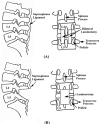Biomechanical comparison of lumbar spine instability between laminectomy and bilateral laminotomy for spinal stenosis syndrome - an experimental study in porcine model
- PMID: 18547409
- PMCID: PMC2438358
- DOI: 10.1186/1471-2474-9-84
Biomechanical comparison of lumbar spine instability between laminectomy and bilateral laminotomy for spinal stenosis syndrome - an experimental study in porcine model
Abstract
Background: The association of lumbar spine instability between laminectomy and laminotomy has been clinically studied, but the corresponding in vitro biomechanical studies have not been reported. We investigated the hypothesis that the integrity of the posterior complex (spinous process-interspinous ligament-spinous process) plays an important role on the postoperative spinal stability in decompressive surgery.
Methods: Eight porcine lumbar spine specimens were studied. Each specimen was tested intact and after two decompression procedures. All posterior components were preserved in Group A (Intact). In Group B (Bilateral laminotomy), the inferior margin of L4 lamina and superior margin of L5 lamina were removed, but the L4-L5 supraspinous ligament was preserved. Fenestrations were made on both sides. In Group C (Laminectomy) the lamina and spinous processes of lower L4 and upper L5 were removed. Ligamentum flavum and supraspinous ligament of L4-L5 were removed. A hydraulic testing machine was used to generate an increasing moment up to 8400 N-mm in flexion and extension. Intervertebral displacement at decompressive level L4-L5 was measured by extensometer
Results: The results indicated that, under extension motion, intervertebral displacement between the specimen in intact form and at two different decompression levels did not significantly differ (P > 0.05). However, under flexion motion, intervertebral displacement of the laminectomy specimens at decompression level L4-L5 was statistically greater than in intact or bilateral laminotomy specimens (P = 0.0000963 and P = 0.000418, respectively). No difference was found between intact and bilateral laminotomy groups. (P > 0.05).
Conclusion: We concluded that a lumbar spine with posterior complex integrity is less likely to develop segment instability than a lumbar spine with a destroyed anchoring point for supraspinous ligament.
Figures





References
Publication types
MeSH terms
LinkOut - more resources
Full Text Sources
Medical

